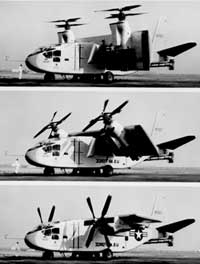Tiltwing on:
[Wikipedia]
[Google]
[Amazon]
 A tiltwing
A tiltwing  The tiltwing design offers certain advantages in vertical flight relative to a tiltrotor. Because the slipstream from the rotor strikes the wing on its smallest dimension, the tiltwing is able to apply more of its engine power to lifting the aircraft. For comparison, the
The tiltwing design offers certain advantages in vertical flight relative to a tiltrotor. Because the slipstream from the rotor strikes the wing on its smallest dimension, the tiltwing is able to apply more of its engine power to lifting the aircraft. For comparison, the
 A tiltwing
A tiltwing aircraft
An aircraft ( aircraft) is a vehicle that is able to flight, fly by gaining support from the Atmosphere of Earth, air. It counters the force of gravity by using either Buoyancy, static lift or the Lift (force), dynamic lift of an airfoil, or, i ...
features a wing that is horizontal for conventional forward flight and rotates up for vertical takeoff and landing. It is similar to the tiltrotor design where only the propeller
A propeller (often called a screw if on a ship or an airscrew if on an aircraft) is a device with a rotating hub and radiating blades that are set at a pitch to form a helical spiral which, when rotated, exerts linear thrust upon a working flu ...
and engine rotate. Tiltwing aircraft are typically fully capable of VTOL
A vertical take-off and landing (VTOL) aircraft is one that can takeoff and landing, take off and land vertically without relying on a runway. This classification can include a variety of types of aircraft including helicopters as well as thrust- ...
operations.Markman, Steve and Bill Holder. "Tilt-Wing VTOL Systems". ''Straight Up: A History of Vertical Flight''. Schiffer Publishing, 2000. .
V-22 Osprey
The Bell Boeing V-22 Osprey is an American multi-use, tiltrotor military transport aircraft, military transport and cargo aircraft with both vertical takeoff and landing (VTOL) and short takeoff and landing (STOL) capabilities. It is designed ...
tiltrotor loses about 10% of its thrust to interference from the wings.
Another advantage of tiltwing aircraft is the ease of transition between VTOL and horizontal flight modes. A tiltrotor must first fly forwards like a helicopter, building airspeed until wing lift is sufficient to allow the nacelles to begin tilting down. As a note, the MV-22 Osprey's stall speed in airplane mode is . Conversely, a tiltwing aircraft can begin the transition from helicopter to airplane at zero forward airspeed. Because of this, the Canadair CL-84 Dynavert was able to take off vertically, then accelerate from zero airspeed to in 8 seconds.
However, the fixed wing of a tiltrotor aircraft offers a superior angle of attack—thus more lift and a shorter takeoff roll—when performing STOL/ STOVL operations.
The main drawbacks of tiltwing aircraft are susceptibility to wind gusts in VTOL mode and lower hover efficiency. The wing tilted vertically represents a large surface area for crosswinds to push against. Tiltrotors generally have better hover efficiency than tiltwings, but less than helicopters. This is due to the difference in rotor disk loading.
As of 2014, NASA
The National Aeronautics and Space Administration (NASA ) is an independent agencies of the United States government, independent agency of the federal government of the United States, US federal government responsible for the United States ...
is testing a diesel-electric hybrid 10-foot 10-rotor tiltwing called the GL-10 Greased Lightning, with most propellers folding during horizontal flight.Warwick, Graham. "Distributed power" '' Aviation Week & Space Technology'' page 31, 25 August 2014. Accessed: 26 August 2014.
List of tiltwing aircraft
Tiltwing designs with rocket, jet, or propeller propulsion * Weserflug P.1003 (1938) * Vertol VZ-2 (1957) * Hiller X-18 (1959) * Kaman K-16B (1959) * LTV XC-142 (1964) * Canadair CL-84 Dynavert (1965) * NASA GL-10 Greased Lightning (2014) * Airbus A³ Vahana (2018)See also
* Thrust vectoring * Tailsitter * Tiltrotor * Tiltjet * Coleopter * PTOL *VTOL
A vertical take-off and landing (VTOL) aircraft is one that can takeoff and landing, take off and land vertically without relying on a runway. This classification can include a variety of types of aircraft including helicopters as well as thrust- ...
* Variable-incidence wing
References
{{Aircraft types (by method of thrust and lift) Aircraft configurations